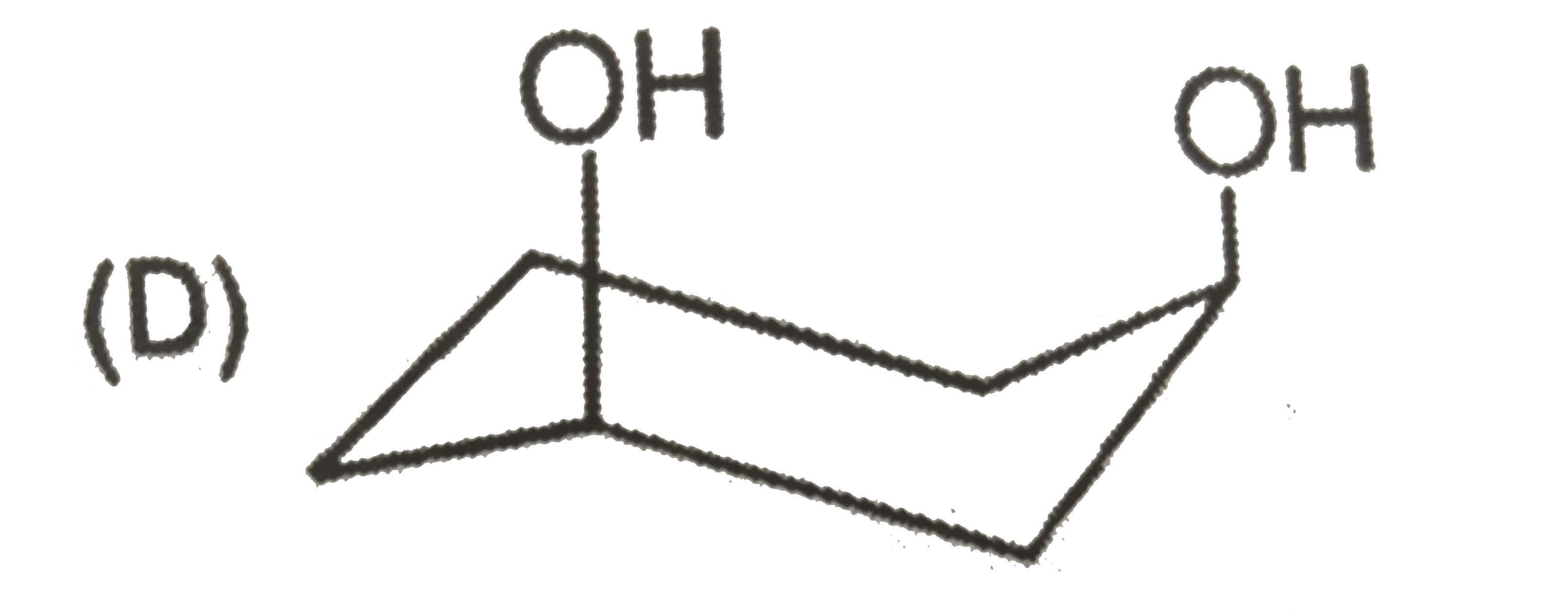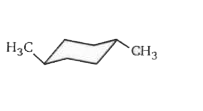The most stable form of cis cyclohexane -1,3-diol is represented as :1




The correct Answer is:D
To determine the most stable form of cis cyclohexane-1,3-diol, we need to analyze the different conformations of the molecule. Here’s a step-by-step solution:
Step 1: Understand the Structure
Cis cyclohexane-1,3-diol has two hydroxyl (-OH) groups located on the 1st and 3rd carbon atoms of the cyclohexane ring. The "cis" designation indicates that these groups are on the same side of the ring.
Step 2: Identify Possible Conformations
In cyclohexane, substituents can occupy two types of positions: axial (pointing up or down from the plane of the ring) and equatorial (pointing outwards from the ring). For 1,3-diol, we can have:
- Axial - Axial (both -OH groups in axial positions)
- Equatorial - Equatorial (both -OH groups in equatorial positions)
- Axial - Equatorial (one -OH group in axial and one in equatorial)
Step 3: Analyze Stability
1. Axial - Axial Conformation: When both -OH groups are in axial positions, they experience steric hindrance due to 1,3-diaxial interactions. However, they can also form hydrogen bonds with nearby hydrogen atoms, which can stabilize the structure.
2. Equatorial - Equatorial Conformation: In this conformation, both -OH groups are in equatorial positions, which minimizes steric hindrance. However, they are too far apart to form hydrogen bonds effectively, leading to a less stable configuration.
3. Axial - Equatorial Conformation: This configuration has one -OH group in an axial position and the other in an equatorial position. This arrangement can lead to some steric strain but allows for some hydrogen bonding.
Step 4: Compare the Stability
- The axial - axial configuration, despite the steric strain, allows for hydrogen bonding, which can overcome the energy barriers created by the 1,3-diaxial interactions.
- The equatorial - equatorial configuration is less stable due to the lack of hydrogen bonding.
- The axial - equatorial configuration is also less stable than the axial - axial due to the presence of steric strain.
Conclusion
The most stable form of cis cyclohexane-1,3-diol is the axial - axial conformation because the hydrogen bonding can effectively stabilize the structure despite the steric hindrance.
Final Answer
The most stable form of cis cyclohexane-1,3-diol is represented as D (axial - axial).
---
Cis cyclohexane-1,3-diol has two hydroxyl (-OH) groups located on the 1st and 3rd carbon atoms of the cyclohexane ring. The "cis" designation indicates that these groups are on the same side of the ring.
In cyclohexane, substituents can occupy two types of positions: axial (pointing up or down from the plane of the ring) and equatorial (pointing outwards from the ring). For 1,3-diol, we can have:
- Axial - Axial (both -OH groups in axial positions)
- Equatorial - Equatorial (both -OH groups in equatorial positions)
- Axial - Equatorial (one -OH group in axial and one in equatorial)
1. Axial - Axial Conformation: When both -OH groups are in axial positions, they experience steric hindrance due to 1,3-diaxial interactions. However, they can also form hydrogen bonds with nearby hydrogen atoms, which can stabilize the structure.
2. Equatorial - Equatorial Conformation: In this conformation, both -OH groups are in equatorial positions, which minimizes steric hindrance. However, they are too far apart to form hydrogen bonds effectively, leading to a less stable configuration.
- The axial - axial configuration, despite the steric strain, allows for hydrogen bonding, which can overcome the energy barriers created by the 1,3-diaxial interactions.
- The equatorial - equatorial configuration is less stable due to the lack of hydrogen bonding.
- The axial - equatorial configuration is also less stable than the axial - axial due to the presence of steric strain.
The most stable form of cis cyclohexane-1,3-diol is the axial - axial conformation because the hydrogen bonding can effectively stabilize the structure despite the steric hindrance.
The most stable form of cis cyclohexane-1,3-diol is represented as D (axial - axial).
Topper's Solved these Questions
- STEREOISOMERISMBOOK - RESONANCE ENGLISHCHAPTER - STEREOISOMERISMEXERCISE - EXERCISE (PART III MATCH THE COLUMN)
1 Videos
- STEREOISOMERISMBOOK - RESONANCE ENGLISHCHAPTER - STEREOISOMERISMEXERCISE - EXERCISE (PART I ONLY ONE OPTION CORRECT TYPE)
10 Videos
- STEREOISOMERISMBOOK - RESONANCE ENGLISHCHAPTER - STEREOISOMERISMEXERCISE - EXERCISE (PART II SECTION (J))
11 Videos
- SOLUTIONSBOOK - RESONANCE ENGLISHCHAPTER - SOLUTIONSEXERCISE - Advabced Level Problems (PART-2)
35 Videos
- STRUCTURAL IDENTIFICATIONBOOK - RESONANCE ENGLISHCHAPTER - STRUCTURAL IDENTIFICATIONEXERCISE - Advanced level Problems (Part-III)
12 Videos
Similar Questions
Knowledge Check
The most stable conformation of cyclohexane is
ABoatBHalf-chairCChairDTwist-boatThe stable form of trans-1, 4 dimethylcyclohexane is represented as:
A B
B C
C D
D
The most stable enolic form of 2, 4-pentanedione is :
ACH2=OH∣CH−CH2−O∣∣C−CH3BCH3=OH∣C=CH−O∣∣C−CH3CCH2=CH∣OH−CH2−C∣∣O−CH3DCH3=C∣OH=C=C∣OH−CH3
The stable conformer (s) of cis-cyclohexane 1−3− diol is/are:
View SolutionWhich is most stable conformer of ethan-1,2-diol
View SolutionGive structural formula of : cyclohexan-1,2-dione
View SolutionThe most stable from trans-1,2-dimethyl cyclohexane is:
View SolutionThe most stable confomation of cis-1,4-di-t-buty1 cyclohexane is:
View Solution
